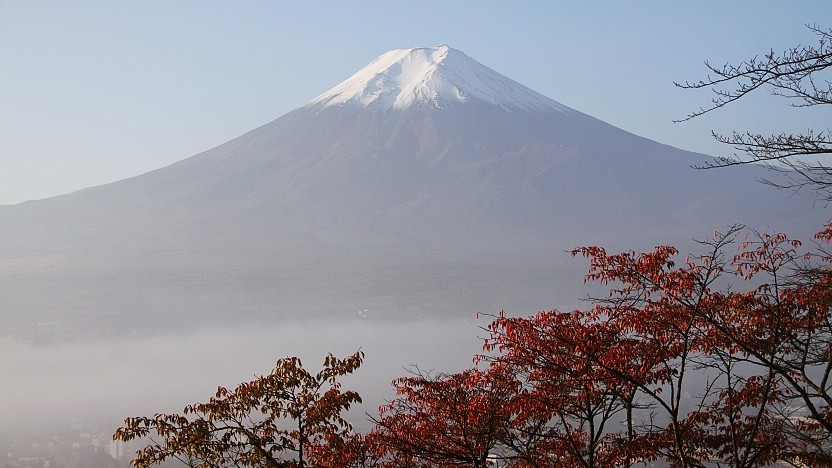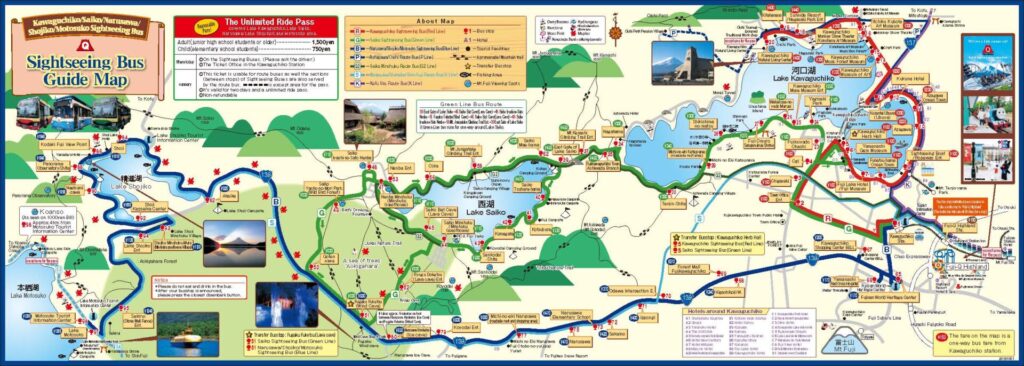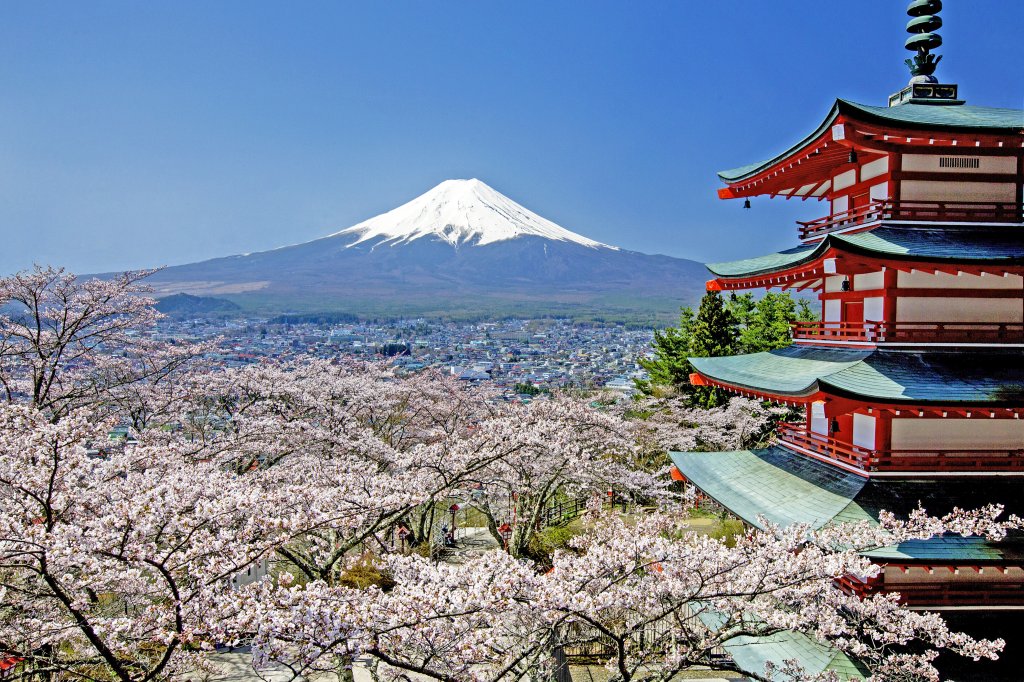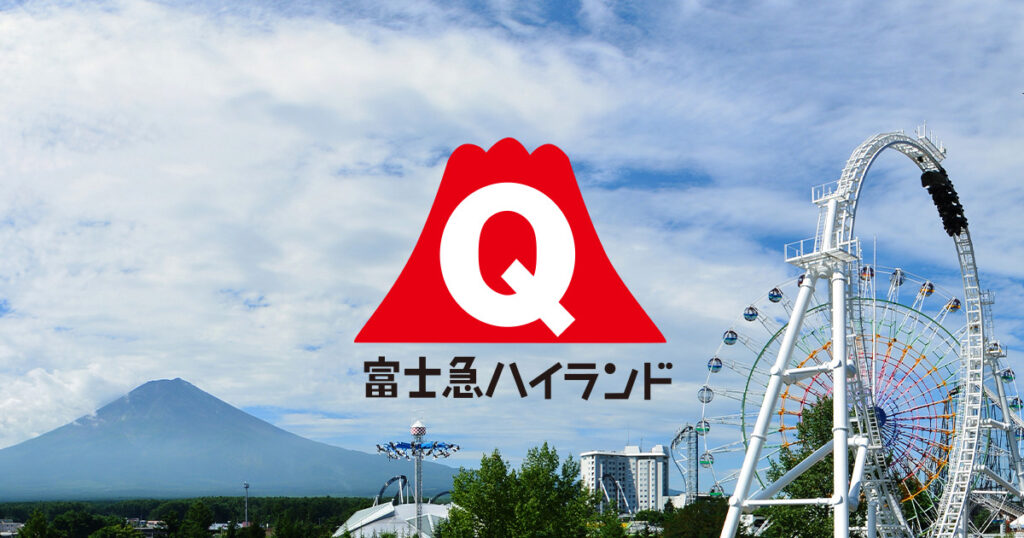Mt. Fuji, which has been worshipped as an object of faith since ancient times and has produced numerous works of art, was registered as a World Cultural Heritage in 2013. As a world-class symbol of Japan, it will be handed down to future generations along with its precious history and culture.Fuji has been revered and revered not only for its isolated beauty, but also as a mountain where gods reside due to its wild eruptions.Fuji was an object of “far-reaching worship” for ancient people, who looked up to it from afar, and Sengen Shrine was built at its foot to quell its eruptions.Even today, in summer, many climbers head for the summit of Mt. Fuji to worship “Goraiko” (the rising sun) or to make the “Hachi (bowl) rounds”.
As living proof of their faith, the mountain trail, along with the shrines and lakes at the foot of the mountain, was registered as a component of the World Heritage List.
Fuji is located between Shizuoka and Yamanashi Prefectures, and each has its own way of seeing and enjoying the mountain. In this issue, we will provide information from the Yamanashi Prefecture side.

【Transportation / Access】
OptionA : Bus from Shinjuku in Tokyo *(on weekdays) Recommend
・Highway bus Basta Shinjuku→Fujigoko Route map is here
Advance reservation is recommended.
For a special bus ticket, click here
*Expressway congestion is expected on Saturdays and Sundays.
Found Good tour site! Let’s check this out!
OptionB : Train from Shinjuku in Tokyo
・Fuji Kaiyu Limited Express
Three round trips a day, but this is by far the easiest, as it connects the JR Chuo Line to the Fujikyuko Line, eliminating the need to change trains.
・Limited Express(JR Chuo Honsen) & Fujikyu Line
For those who cannot make the above Fuji Kaitour by any means, please check the website.
JR website
Shinjuku→Otsuki (JR Chuo Line) approx. 1H *Advance reservation is required!
Transfers: It is easy to make a mistake, so please check this Youtube!
Fujikyu website
Otsuki→Kawaguchiko (Fujikyu line) about 50~60 min.
Fujikyu Group Free Tour Bus
The cute buses departing from and arriving at Kawaguchiko Station are perfect for touring around the sightseeing spots.
Kawaguchiko Sightseeing Bus (Red-Line), Saiko Sightseeing Bus (Green-Line), Narusawa/Shojiko/Motosuko Sightseeing Bus (Blue-Line)

Fuji, the snow-capped Mt. Fuji that everyone envisions, can usually be seen from October to May, but from June to September, there is usually almost no snow. If you are visiting Mt. Fujifrom far away, choose the right time of year to avoid disappointment.
・Climbing Mt.Fuji:Closed in winter. Climbing is possible only when the snow melts. The opening of the mountain on the Yamanashi side is around July 1, and will end around September 10. Please be sure to check the official website for climbing Mt. Fuji in advance and be well prepared for your trip
Also, mountain lodges are quite crowded on weekends, and you may not be able to stay overnight without a reservation, so we recommend that you plan ahead and make a reservation.
・Fuji Five Lakes
A generic name for five lakes located at the foot of Mount Fuji on the Yamanashi Prefecture side. Fuji on the Yamanashi Prefecture side. They were named by Ryohei Horiuchi, the founder of Fujikyu Line. All lakes are dammed by the eruption of Mt. Fuji and are designated as Fuji-Hakone-Izu National Park.
・Lake Kawaguchi: A place where history and culture can be felt and where numerous spots for Mt. Oike Park, the site of the lake festival and winter fireworks, and Lake Kawaguchi, with its lakeside inns, hotels, and stores, are the main areas of the city that are ideal for sightseeing.
・Lake Yamanakako : The lake is the closest of the Fuji Five Lakes to Mt. It has become a cyclist-friendly city, having been the course for a bicycle road race during the Tokyo Olympics.
・Lake Motosu : With a depth of 121.6 m, the lake boasts the “No. 1 transparency in Honshu” and is the lake on which the upside-down Fuji depicted on the 1,000-yen bill appears.
・Arakurayama Sengen Park : The five-story pagoda is the symbol of this shrine. There is also an observation deck that offers a panoramic view of Mt. The observation deck has been renovated and may be crowded.
・Oshinohakkai: A natural monument, “Oshinohakkai” is a spring-fed pond whose source is the underground water of Mt.Fuji.
・Fugaku Wind Cave : it is surrounded by the lush greenery of the Aokigahara Sea of Trees. Once inside, it is cool and refreshing even in summer, with an average temperature of 3 degrees Celsius.
・Narusawa Ice Cave : One of the lava caves at the foot of Mt. The average temperature inside is as low as 3 degrees Celsius, and it is covered with ice all year round.
・The Museum of Music Boxes in the Park : Visitors can enjoy the beautiful garden, lush nature, and the spectacular view of Mt.Fuji.
・Fujikyu Highland : An amusement park located at the foot of Mt. Fuji to your heart’s content from the “Fujiyama Sky Deck,” which was completed in 2021. Fuji to your heart’s content from the new FUJIYAMA SKY DECK, which was built in 2021. We recommend that you book a ticket with a train or bus package when you visit the park.
・Fujiyama Museum: The museum has one of Japan’s largest collections of artworks, including paintings featuring Mt.Fuji.
・Fujiyama Onsen:Next to Fujikyu Highland in Kawaguchiko, a purely Japanese style one-day hot spring where you can stop by after climbing Mt.Fuji.
>> #2 is about Events, accommodation, and plus α sightseeing! check it out!


【背景】太古から信仰の対象として人々に崇められ、数多くの芸術作品を生み出している富士山は、平成25年に世界文化遺産へ登録されました。世界に誇る日本の象徴として、その貴重な歴史や文化とともに後世に継いでいきます。富士山は、その孤高の美しさだけでなく、荒ぶる噴火により、神の住む山として畏れられ、崇められてきました。古の人々にとって、富士山は遠くから仰ぎ見て崇拝する「遙拝」の対象であり、富士山の噴火を鎮めるために、富士山の麓に浅間神社が建立されました。現在も、夏になると多くの登山者が、「御来光」を拝んだり、「お鉢めぐり」をするために、富士山の山頂を目指します。登山道は、信仰の生きている証として、山麓の神社や湖などとともに、世界遺産の構成資産として登録されました。
富士山は静岡県と山梨県の間に位置しており、それぞれの見方、楽しみ方があります。今回は山梨県側からの情報をお知らせします。
【交通・アクセス】
A. 都内新宿からバス *(平日の場合)オススメ
・高速バス バスタ新宿→富士五湖行き
事前の予約をお勧めします。お得なバスチケットはこちら *土日は高速道路の渋滞が予想されます
B. 都内新宿から電車
・特急富士回遊
1日3往復ですが、断然にこちらが楽です。JR中央本線から富士急行線に乗り入れており、乗り換えが不要です。
・ JR中央本線特急+富士急行線 上記の富士回遊だとどうしても時間が合わない方にはこちら。
新宿→大月(JR中央本線)約1H *事前予約が必要です!
大月→河口湖(富士急行線)約50~60分
★富士急グループ無料巡回バス
河口湖駅を起点に発着する可愛らしい3色の周遊バスは、観光地を巡るのにピッタリ。
【観光のポイント】
実は、皆さんが思い描く富士山、あの雪化粧した富士山は大体10月〜5月位までは見られますが、6月~9月はほぼ雪のないことが普通です。遠方から富士山を訪れる方は、ガッカリすることのないよう、時期を選びましょう。
・富士登山:冬は閉鎖しています。雪解けの期間だけ登山が可能です。山梨側の山開きは7/1辺りです。9/10頃には終了します。必ず、富士登山オフィシャルサイトを事前に確認し、しっかりと準備をしたうえでお出かけください。また、山小屋も週末はかなり混み合い、予約なしでは宿泊できない場合もあるので、事前に計画を立てて予約をお勧めします。
・富士五湖 : 山梨県側の富士山麓に位置する5つの湖の総称。下記の5つの湖を指す。富士急行の創設者である堀内良平によって命名された。 本栖湖 〈もとすこ〉 精進湖 〈しょうじこ〉 西湖 〈さいこ〉 河口湖 〈かわぐちこ〉 山中湖 〈やまなかこ〉 いずれも富士山の噴火による堰止湖で、富士箱根伊豆国立公園に指定されている。
・河口湖:歴史や文化を感じられる場所そして数多くの富士山スポットがあります。湖上祭や冬花火の会場となる大池公園や、湖畔添いに旅館・ホテルやショップなどが立ち並ぶ河口湖は観光拠点として最適のメインエリアです。
・山中湖:富士五湖の中でも最も富士山に近い湖。東京オリンピックで自転車のロードレースのコースになり、サイクリストに優しい街となっています。
・本栖湖:水深は、121.6mあり、「本州No1の透明度」を誇り、千円札に描かれている逆さ富士が写っている湖が本栖湖です。
・新倉山浅間公園:五重塔がシンボルの神社。展望デッキもあり、富士山を一望できます。展望デッキはリニューアルし、混雑する可能性があります。
・忍野八海:天然記念物である「忍野八海」は、富士山の伏流水に水源を発する湧水池です。
・富岳風穴:青木ヶ原樹海の豊かな緑に囲まれた富岳風穴。中に入ると夏でもひんやりと涼しく、平均気温は3度。
・鳴沢氷穴:富士山麓の溶岩洞窟の一つ。内部の気温は平均3度と低く、1年中氷におおわれている。
・オルゴールの森美術館 : 美しい庭園と豊かな自然、絶景の富士と共に貴族たちが愛したオルゴールや、自動演奏楽器による心癒される音楽を、時代を越えてお楽しみいただけます。
・富士急ハイランド : 富士の裾野にあるアミューズメントパークとして“世界一”のアトラクションを多く備え、絶叫系の乗り物が多いことで人気がある。2021年にできた『FUJIYAMAスカイデッキ』からは心行くまで富士山の絶景を堪能できる。来場する際は、ぜひ電車やバスとパッケージになったチケットを予約することをお勧めします。
・フジヤマミュージアム 富士山をとりあつかった絵画をはじめとする美術品のコレクションは日本最大級。
・ふじやま温泉:河口湖の富士急ハイランド隣り、富士登山帰りに立ち寄れる純和風の日帰り温泉



コメント